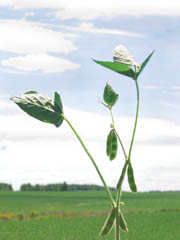Environmental concerns, including the need for adhesives made from a renewable feedstock, have caused a resurgence of interest in developing new soy-based products for the wood adhesives industry. The United Soybean Board has funded both fundamental and applied research with a goal of developing new soy-based adhesives that can be used alone or with existing products to provide equal or superior performance, good manufacturing economies and environmental advantages. Current research is concentrating on soy-hydrolyzate and soy-flour adhesives.

Reducing Air Emissions
Air emissions of volatile organic compounds (VOCs) and hazardous air pollutants (HAPs) contribute to a variety of modern maladies, from smog to the "sick building syndrome." Formaldehyde, a major constituent of many wood adhesives today, and phenol resins have been especially targeted. The use of soy adhesives may not replace these compounds completely, but instead allow continued growth in wood product manufacturing to meet growing world demand, while stabilizing or even reducing total emissions of air pollutants. A two-part contact system in which soy hydrolyzate replaces half of the phenol-resorcinol-formaldehyde is being used to make finger-jointed lumber. This halving of the use of the problematic compound has the potential to reduce emissions in the atmosphere and the workplace, allowing for greater worker safety. An added benefit is the reduction of energy needed to cure the soy-based adhesive.
Finally, the new soy system allows the jointing of green lumber. The lumber can be processed to remove knots and imperfections, the primary source of VOC emissions, before gluing. This aids significantly in reducing the VOC emissions, or "blue smoke," associated with kiln drying of wood.
Easy Disposal and Handling
Soy-hydrolyzate and soy-flour adhesives do not require hazardous waste disposal. In their uncured form, they are aqueous solutions that wash away easily with water. They are nonvolatile and have a relatively high pH, requiring only normal protective gloves and safety glasses for safe handling.A Natural, Renewable Resource
America's soybean farmers currently produce close to 3 billion bushels of soybeans annually. This large, stable supply of a renewable natural resource presents manufacturers with an inexhaustible raw material. Soybeans are legumes that fix their own nitrogen from the atmosphere and therefore require no petroleum-based nitrogen fertilizers. In rotation with nitrogen-deficit crops such as wheat, cotton, rice or corn, soybeans leave residual nitrogen in the soil to further reduce farm dependence on nitrogen fertilizers, which are made primarily from natural gas.Benefiting Society
Substituting soy as a raw material for the petroleum ingredients used in making adhesives should lower air emissions while helping to preserve clean water, and should also reduce worker exposure to potentially toxic compounds. Reducing industry dependence on petrochemicals and farm dependence on nitrogen fertilizers helps to conserve energy. Growth in the farm sector creates new jobs and stimulates both rural and urban economies.
Soy adhesives are only one small piece of the puzzle, but with a continued commitment to using natural, renewable materials as raw material feedstocks, a better future can be realized.